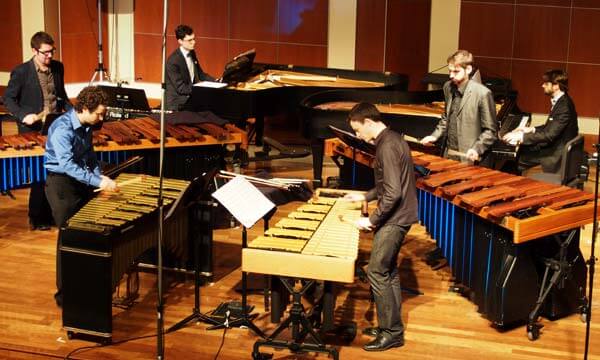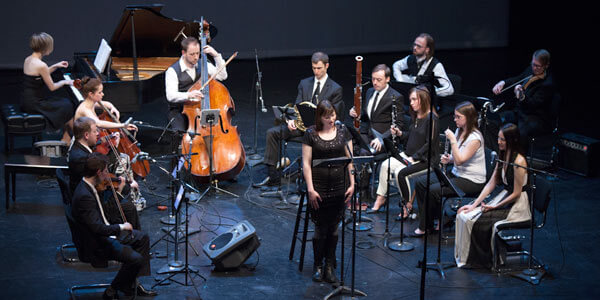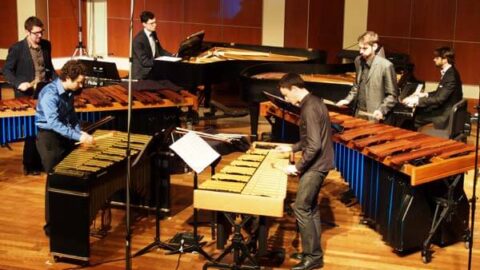 Chicago is a hot burning bonfire of contemporary music, bursting with talented composers, expert players/ensembles, and a growing, appreciative audience. Some weeks there are more performances than it is physically possible to attend, a phenomenon we have hash-tagged #ChicagoNewMusicPlethora. We faced the latest of these dilemmas on the weekend of March 8-10, 2013 when we attended concerts by Third Coast Percussion, Fifth House Ensemble, and Spektral Quartet. Three outstanding concerts in three days . . . and we had to skip at least four others in the process.
Chicago is a hot burning bonfire of contemporary music, bursting with talented composers, expert players/ensembles, and a growing, appreciative audience. Some weeks there are more performances than it is physically possible to attend, a phenomenon we have hash-tagged #ChicagoNewMusicPlethora. We faced the latest of these dilemmas on the weekend of March 8-10, 2013 when we attended concerts by Third Coast Percussion, Fifth House Ensemble, and Spektral Quartet. Three outstanding concerts in three days . . . and we had to skip at least four others in the process.

There was no reason to expect any unity among these concerts. But experiencing them in quick succession revealed some common threads that wove them into a cohesive whole. Iconic Reich minimalism jumped to Caleb Burhans and landed in the exactitude of Mozart. Crumb’s multivalent complexities echoed in the psychological dramas of Shostakovich and Carter. The most striking commonality was the sheer precision that performance of each piece required, revealing the fierce dedication of these players to their calling.
On Friday, March 8, we experienced Third Coast Percussion, with guest pianists Timo Andres and David Kaplan, performing George Crumb’s Makrokosmos III: Music for a Summer Evening and Steve Reich’s Sextet at the Merit School of Music. They gave an exhilarating account of Sextet, From its start on two pianos, six hands, plus two electronic keyboard, the musicians blazed through its minimalist progressions with precision and joy. In the raucous conclusion, we thought David Skidmore might come right out of his shoes as he threw his whole being into the final cascade of blows to the vibraphone.
Crumb’s paean to the sounds of nature was the revelation of the evening, carrying us away with its intricate loops and entanglements. There were quiet moments when each pianist hit a single key with his other hand plucking a string, allowing those sounds to swell and resonate. Sometimes there was just a faint whistle or chant; then loud, complex, cacophonous playing rung out through the hall. The final section, Music of the Starry Night, began with a startling three chords on piano and percussion, followed by complex playing that resolved into a simple melody. The marimba and pianos played to and at each other until all six musicians played at once, not exactly in sync. It was as if they were on a evening walk in the woods, together, but at different paces. Each occasionally wandered off the path, yet all headed to the same destination.
 Saturday, March 9, took us to the Museum of Contemporary Art where Fifth House Ensemble presented John Zorn’s The Temptations of St. Anthony, the Shostakovich String Quartet No. 9, and Caleb Burhans’ Excelsior. For the latter piece, they were joined by guest artists soprano Martha Cluver, guitarist Grey McMurray, and Burhans himself on electric violin. This concert, the latest episode in Caught,a yearlong narrative chamber music series, focused on testing the bounds of human limitations by examining “three historical figures and their flirtations with escape.” Zorn’s rumination embodies St. Anthony in the piano, played by Jani Parsons, roaming the desert testing his faith in the face of demons and furies (the other instruments). The Shostakovich quartet was presented with projected cartoons by artist Adam Fotos, highlighting his struggle as an artist living in the Soviet Union.
Saturday, March 9, took us to the Museum of Contemporary Art where Fifth House Ensemble presented John Zorn’s The Temptations of St. Anthony, the Shostakovich String Quartet No. 9, and Caleb Burhans’ Excelsior. For the latter piece, they were joined by guest artists soprano Martha Cluver, guitarist Grey McMurray, and Burhans himself on electric violin. This concert, the latest episode in Caught,a yearlong narrative chamber music series, focused on testing the bounds of human limitations by examining “three historical figures and their flirtations with escape.” Zorn’s rumination embodies St. Anthony in the piano, played by Jani Parsons, roaming the desert testing his faith in the face of demons and furies (the other instruments). The Shostakovich quartet was presented with projected cartoons by artist Adam Fotos, highlighting his struggle as an artist living in the Soviet Union.

Burhans’ Excelsior, the highlight of the evening, celebrated the feats of Air Force Colonel Joseph Kittinger’s 1960 sky-dive from 20 miles high, part of space exploration research. The performance was accompanied by archival footage, including video from a camera in Kittinger’s helmet. The piece commands soprano, electric violin, electric guitar, flute, oboe, clarinet, bassoon, horn, violin, viola, cello, bass and piano, sufficient resources to sound symphonic when everyone was playing. It began with peaceful humming followed by a step into the abyss with forceful low register entreaties by piano, cello, bass, and bass clarinet. The music unfolded in an ethereal, floating swirl through the ensemble, marking Kittinger’s four-minute-thirty-three-second free fall, then burst forth with intensity following the opening of his parachute.
 Sunday, March 10, marked our first visit to the spectacular new Reva and David Logan Center for the Arts at University of Chicago to hear Spektral Quartet play Mozart’s String Quartet No. 21 in D Major K. 575, Chris Fisher-Lochhead’s Dig Absolutely, and Elliott Carter’s String Quartet No. 2. When the first bars of the Mozart filled the small room with sweet, familiar chords, sounding so much richer than any recording, we knew we were in for a treat.
Sunday, March 10, marked our first visit to the spectacular new Reva and David Logan Center for the Arts at University of Chicago to hear Spektral Quartet play Mozart’s String Quartet No. 21 in D Major K. 575, Chris Fisher-Lochhead’s Dig Absolutely, and Elliott Carter’s String Quartet No. 2. When the first bars of the Mozart filled the small room with sweet, familiar chords, sounding so much richer than any recording, we knew we were in for a treat.

Fisher-Lochhead was there, lending a special energy to the performance of Dig Absolutely, a seminal piece in the artistic development of both composer and ensemble. Violinist Aurelian Pederzoli and violist Doyle Armbrust sprang vigorously into the staggering and swaying opening, shortly joined by violinist Austin Wulliman and cellist Russell Rolen. They segued into a section of scratchy bowing with a very light tough, then long slow bowing that sounded like a train whistle far off in the distance. An almost symphonic passage followed with big, brash notes in an uncertain pitch relationship. The conclusion cycled back to light-touch bowing, high on the necks of their instruments, making atmospheric dream sounds of unknown origin. We dug it, absolutely.
Carter’s kaleidoscopic musical maze brought the event to a close. The musicians each introduced us to the character they were portraying, as Carter’s score instructs them to do, and recommended we have fun with the piece and not take it too seriously. The music unfolded in individual harmonic lines in each instrument, but often in dissonant conflict with each other. Like four guests at a cocktail party competing for our attention, they proceeded as if oblivious to what each others was doing. There were short passages when they all played together, only to be disrupted by one insistent on being in charge. By the end, the intensity of the differentness increased, and as the pace grew faster that differentness strengthened. But they managed to all come to a screeching halt at the same time.
–
Arlene and Larry Dunn are pure amateurs of contemporary music. Visit their blog at Acornometrics and follow them on Twitter: @ICEfansArleneLD.
























